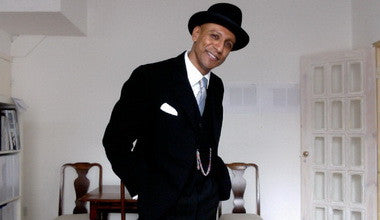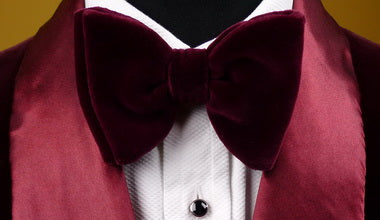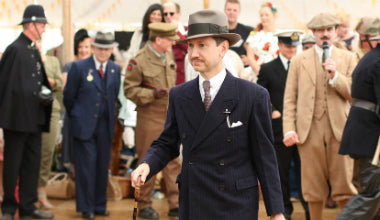
At first, black tie 'rules' might appear somewhat rigid and prescriptive but, as always, the enjoyment is in the detail. Subtle variations in cut and finish enable savvy chaps to reflect their individual taste without ever appearing immodest (that would, of course, constitute the height of bad manners). Our introductory guide may just provide inspiration and some small steps toward reassurance. We will add to this guide as time and memory allows!
Cloths
Barathea Wool - considered the most reliable choice for formal dinner suits (and evening tailcoats). Most vintage pieces are found in 16oz weight - heavier than anything you'll find on today's high street (and quite a shock to those who have only experienced flimsy nylon and lycra man-mades!). A good barathea will last a lifetime and never look out of place. Vintage barathea DJs are widely available, quality is routinely excellent, and so is value for money.
Mohair / Wool Mix - dull sheen finish, lighter weight and somewhat less formal. Originating in the 1950s, (and now de-riguer for 'Mad-Men', apparently). Can certainly look the part if the detailing is respectful to classic black tie 'rules'. One of the few occasions when a shiny suit would not be considered a little silly!
Velvet - a more 'dandy' alternative, perhaps. Found in a variety of colours, originally derived from the smoking jacket and often still described as such. Silk-velvet examples are highly sought-after, and rightly so.
Polyester & variants of - while it's true that even some of the most respected tailors flirted with 'man-mades', especially in the 1970s (of course!), such fabrics should be treated with caution. Often found with 'fashionable' styling, one should examine detailing carefully to be sure of quality and, if in doubt, shouldn't rely on them for more formal occasions.
Colours - the 'classics' are now considered to be black, midnight blue (which can appear 'more black than black' under artificial lighting), and ivory for wear in hotter climates or on less formal occasions. Velvets aside, other colours are now considered as 'fashion', more suitable for less formal occasions. It wasn't always the case, though; prior to World War 2, and the appearance of ready-made clothing, burgundy, bottle green and even brown were not unheard of. Lately, more flamboyant chaps are turning to tartan jackets or trousers (though, never both).
Jacket Styles
Double Breasted - with peak lapel, 1/2 or 1/4 button fastening, grosgrain (finely ribbed silk) facings, jetted hip pockets (no flaps), welt top pocket, unvented.
Single-breasted - most commonly with satin or grosgrain shawl collar, although 1-button single-breasted with grosgrain peak lapel is also a classic and distinctive cut (and Mr Tiernan's personal favourite!) that was prominent in the 1930s and is now making a comeback.
Ivory jackets can be found in both single and double-breasted styles but often have self-facings (i.e the lapel is made from the same material as the jacket body rather than a contrasting silk / satin). Lighter-weight (sometimes linen but we prefer a fine worsted), most suitable for warm climates, don't set sail without one!
Trousers
Should be the same material as the jacket (except for ivory or tartan jackets, and velvet jackets, which should all be worn with black trousers) and the single braid leg band should match the jacket facings. Single or twin pleats (forward facing), cut for braces (curved waistband, notch-back, high waisted / rise), gently tapered leg, no turn-up / cuff. Waist adjusters became popular in the 1960s, along with a lower waisted cut.
Shirts
Wing collars were, until recently, considered the more formal choice (probably a carry forward from their wear with evening tailcoats), but we would actually propose the 'standard' forward turn-down collar as the most appropriate choice with a classic DJ. Marcella finish most formal, Sea Island or Poplin cotton (with or without pleats) are also perfectly appropriate. White, always, (the 1970s craze for pink or blue with frilly decoration is best avoided, unless you are recreating a 'Two Ronnies' inspired outfit!). Look for a shirt that can also accept dress studs, which should be black onyx.
Necks & Waists
Bow Ties - black is traditional, and always appropriate. Barathea or satin (to match jacket facings). Pre-tied might appear convenient but, once learnt, self-tie will give an obviously superior result.
Waistcoats - the classic style is low cut with three buttons and a shawl lapel. Usually black or midnight blue barathea (to match the dinner jacket).
Cummerbunds - first adopted by British Army Officers in colonial India. Found in a wide range of fabrics and colours, from grosgrain to velvet and iradescent acetate (in any event, your cummerbund and bow tie should match). The very best ones have a small ticket pocket sewn into the pleats (which should always be worn facing up).






Comments
My dear Mr Tiernan,
Your name should never be misspelt: Tioernan as above…it just will not do for the sartorial KING of Albion!!
Thank you for the wonderful advice. I have much to learn; thanks to you I have come so far.
Best wishes,
Happy New Year 2021
Cliff Taylor
A single breasted, peak collar dinner jacket is what I’m after, with inside leg 31", chest 48", waist 44"; that would cut the mustard.
Hi Peter! Take a look at our selection of vintage evening tails: http://www.savvyrow.co.uk/collections/types?q=Evening+Tailcoats
We also have waistcoats and bow ties.
Hope this helps. Best regards, Paul
I am looking for period white tie